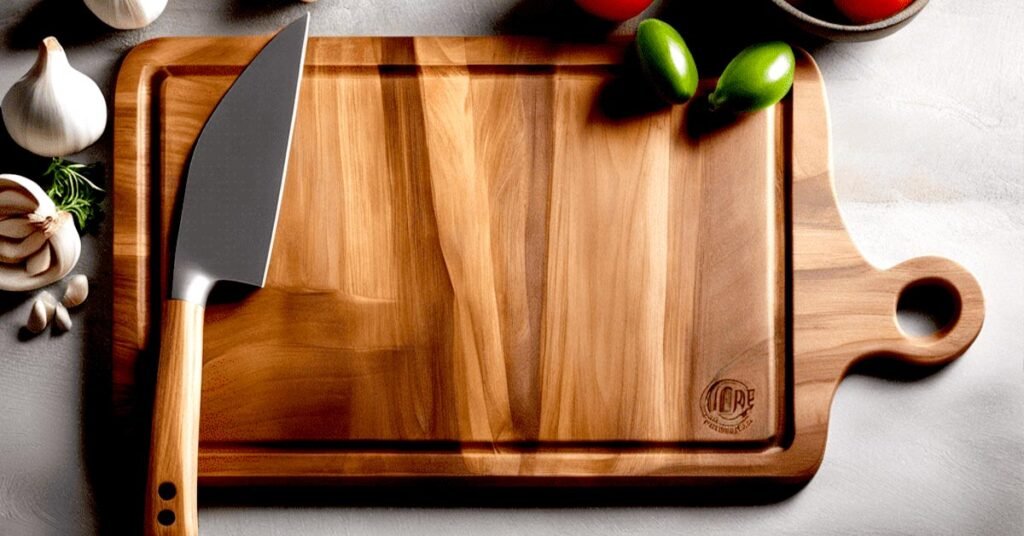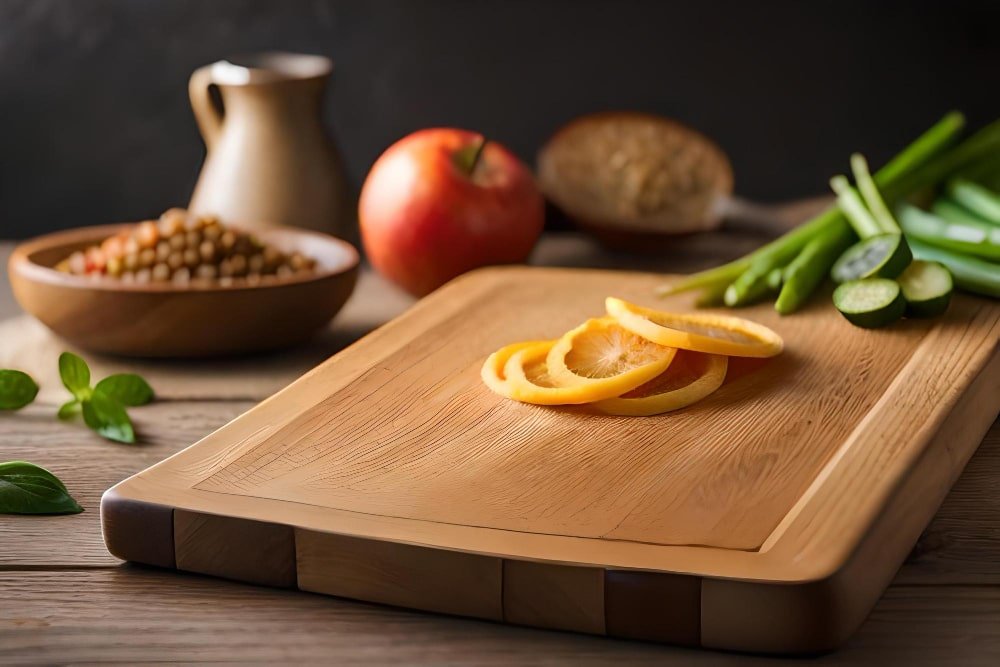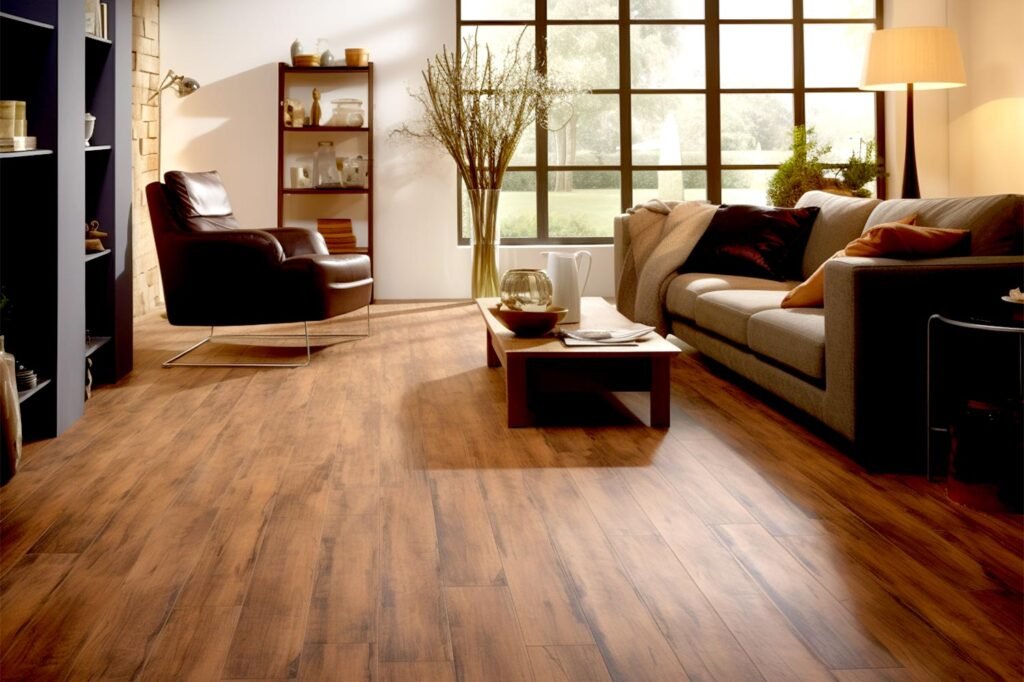In the article we have described the best woods for cutting boards in detail. Choosing the perfect cutting board is a decision that should not be taken lightly. Beyond mere functionality, your choice of cutting board can significantly affect the efficiency and enjoyment of your cooking experience.
But our journey doesn’t stop there. The factors you should consider when choosing wooden cutting boards will be discussed. We’ll also delve into everything from the hardness and durability of our chosen woods to the grain patterns and maintenance requirements. So that you will be able to make an informed decision about the best woods for cutting boards. Which not only fulfills your culinary needs but also enhances the beauty of your kitchen space.
Wooden cutting boards have long been revered in culinary circles for their blend of form and function. Unlike their plastic or glass counterparts, wooden cutting boards offer a warmth and character that can enhance even the simplest of kitchen tasks. But beyond just aesthetics, the type of wood you choose for your cutting board plays an important role in its functionality and longevity.
So, join us as we embark on a quest to unlock the secrets of the best woods for cutting boards. Whether you’re a seasoned chef or a novice home cook, this guide will equip you with the knowledge and confidence to choose the perfect wood cutting board for your culinary adventures. Let’s dive in!
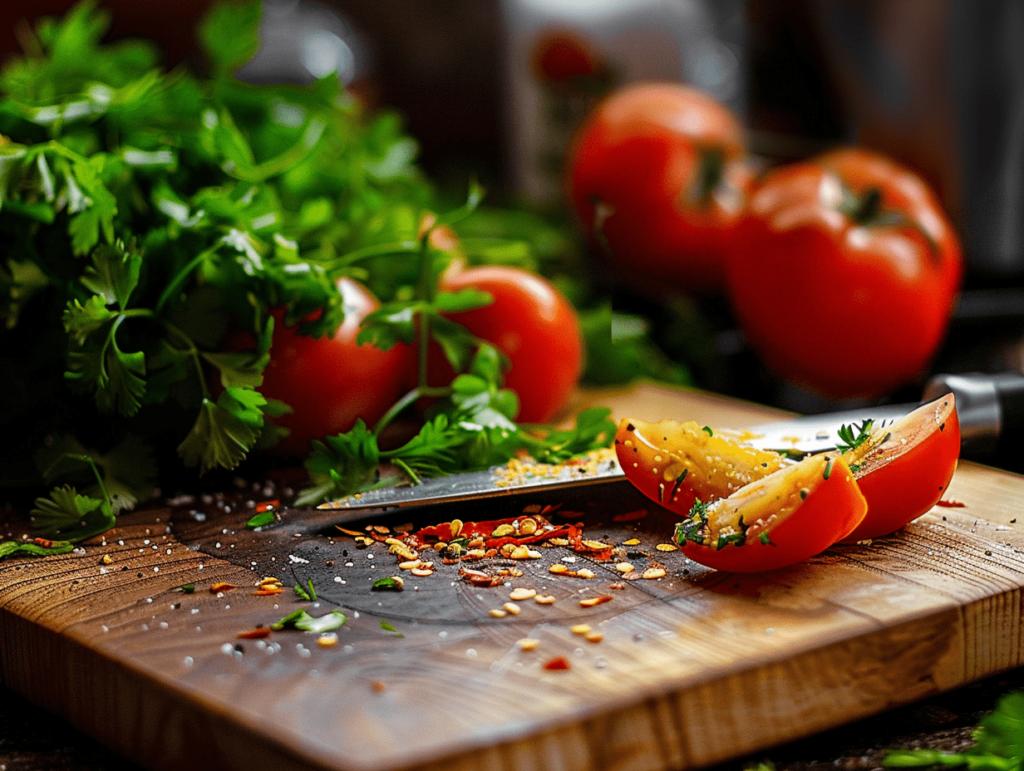
Table of Contents
Toggle5 Best Woods For Cutting Boards
When it comes to selecting the perfect wood for your cutting board, several options stand out for their exceptional durability, aesthetics, and suitability for kitchen use. Let’s explore some of the most popular wood choices, each renowned for its unique qualities and benefits.
1. Maple Wood Cutting Boards:
Maple wood is a perennial favorite among chefs and home cooks alike, prized for its exceptional hardness and durability. Its tight grain pattern creates a smooth cutting surface that is gentle on knives, helping to maintain sharpness over time. Additionally, maple’s light color and natural luster add a touch of elegance to any kitchen space. Whether you’re dicing vegetables or carving meat, a maple wood cutting board is sure to meet your culinary needs with style and precision.
John Boos Chop-N-Slice Maple Wood Cutting Board
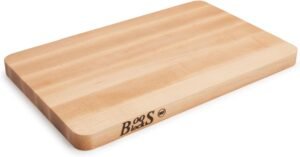
The John Boos Chop-N-Slice Maple Wood Cutting Board is a premium kitchen essential crafted from hand-selected American hard maple wood. With its sturdy end grain design, this square-shaped cutting board offers durability and versatility for everyday culinary tasks.
- Crafted from hand-selected American hard maple wood with end grain design
- Reversible design for versatile use
- Solid construction with hand grips on each side for easy maneuvering
- Luxurious oil finish for protection and enhancement of natural beauty
- Trusted brand since 1887, favored by chefs and restaurateurs
- Some concerns raised about durability and stability, attributed to user error and maintenance issues
- Requires regular oiling and careful maintenance for optimal performance
2. Walnut Wood Cutting Boards:
Walnut wood boasts a rich, chocolate-brown hue and a luxurious grain pattern that adds warmth and character to any kitchen. Beyond its aesthetic appeal, walnut is renowned for its impressive hardness and durability, making it an excellent choice for cutting boards that can withstand heavy use. Despite its density, walnut is relatively easy to work with, allowing for intricate designs and custom shapes. Whether you prefer a classic walnut cutting board or a modern twist, this versatile wood is sure to impress.
Virginia Boys Walnut Wood Cutting Board:
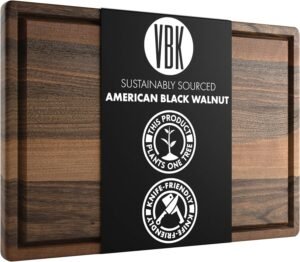
The Walnut Wood Cutting Board by Virginia Boys Kitchens is a premium kitchen essential crafted from 100% sustainable walnut wood grown in America. With its rectangular shape and dimensions of 17″L x 11″W x 0.75″Th, this butcher block wooden carving board offers both style and functionality for all your culinary needs.
- Crafted from 100% sustainable walnut wood grown in America
- Preseasoned with pure fractionated coconut oil for immediate use
- Knife-friendly surface preserves sharpness
- Thick, sturdy, and reversible design for long-lasting durability
- Supports tree planting initiatives, contributing to environmental sustainability
- Some users report initial roughness, though it may smooth out with use
- Additional care products recommended for optimal maintenance, adding to cost
3. Cherry Wood Cutting Boards:
Cherry wood offers a unique blend of beauty and functionality, with its warm reddish-brown hue and smooth, satiny texture. While not as hard as maple or walnut, cherry wood still provides a sturdy cutting surface that is gentle on knives. Over time, cherry wood develops a deep, rich patina that only enhances its natural beauty, making it a timeless addition to any kitchen. Whether you’re chopping herbs or slicing bread, a cherry wood cutting board adds a touch of rustic elegance to your culinary endeavors.
John Boos Cherry Wood Cutting Board:
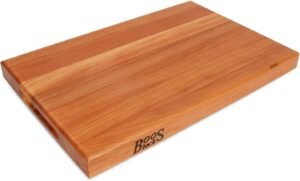
The John Boos Cherry Wood Cutting Board is a versatile kitchen essential designed for food preparation tasks. With dimensions of 18 inches in length, 12 inches in width, and 1.5 inches in thickness, this rectangular cutting board provides ample space for chopping, slicing, and dicing.
- Crafted from hand-selected American hard cherry wood for durability
- Luxurious oil finish enhances natural beauty
- Reversible design for versatile use
- High rating of 4.6 out of 5 stars from 4,144 customer ratings
- Ease of cleaning, giftable nature, and sturdiness praised by customers
- Requires hand washing and regular treatment with John Boos Mystery Oil for maintenance
- Some customers express concerns about durability over time
- Price of $117.95 may be considered high for some buyers, though discounts and financing options are available
4. Bamboo Cutting Boards:
Bamboo has surged in popularity in recent years as a sustainable and eco-friendly alternative to traditional hardwoods. As one of the fastest-growing plants on earth, bamboo is highly renewable and requires minimal resources to cultivate. Despite its rapid growth, bamboo is incredibly strong and durable, making it an excellent choice for cutting boards that can withstand daily use. Its natural resistance to moisture and bacteria also makes bamboo cutting boards easy to clean and maintain, ensuring a hygienic food preparation surface.
ROYAL CRAFT Bamboo Cutting Board:
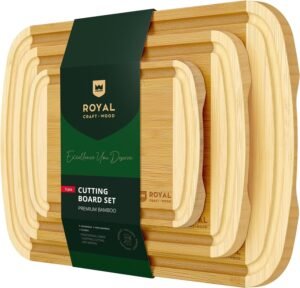
The ROYAL CRAFT WOOD Luxury Cutting Boards for Kitchen is a versatile and practical set of three bamboo cutting boards, perfect for all your food preparation needs. Crafted from smooth bamboo wood, each cutting board features a two-tone design and built-in side handles for easy maneuverability.
- Excellent value for a set of three cutting boards
- Popular choice for housewarming gifts
- Easy to clean by hand washing
- Sturdy construction and durability praised by customers
- Built-in groove catches liquid runoff, preventing spills
- Comprehensive customer support with warranty and money-back guarantee
- Some customers reported durability issues with extended use
- Boards may lack thickness for heavy-duty chopping tasks
5. Teak Wood Cutting Boards:
Teak wood is renowned for its exceptional hardness, durability, and resistance to moisture and decay. Its natural oils and resins make it impervious to water, making it an ideal choice for cutting boards that will be exposed to moisture in the kitchen. Additionally, teak’s rich golden-brown hue and intricate grain pattern add a touch of elegance to any kitchen space. Whether you’re slicing fruit or carving meat, a teak wood cutting board offers both beauty and functionality in equal measure.
Yes4All Durable Teak Cutting Board:

The Yes4All Durable Teak Cutting Board is a premium kitchen essential crafted from 100% natural teak wood, renowned for its durability and aesthetic appeal. Measuring 24 inches in length, 18 inches in width, and 1.5 inches in thickness, this extra-large end grain cutting board offers ample space for all your food preparation needs.
- Crafted from 100% natural teak wood for durability
- End grain construction enhances strength and resilience
- Moisture and stain-resistant properties
- Deep juice groove prevents spills and messes
- Built-in handles for easy carrying
- High overall rating and positive customer reviews
- High price point
- Requires occasional maintenance with vegetable oil
- Originates from Vietnam, which may be a consideration for some buyers
Wooden Cutting Boards: Key Considerations
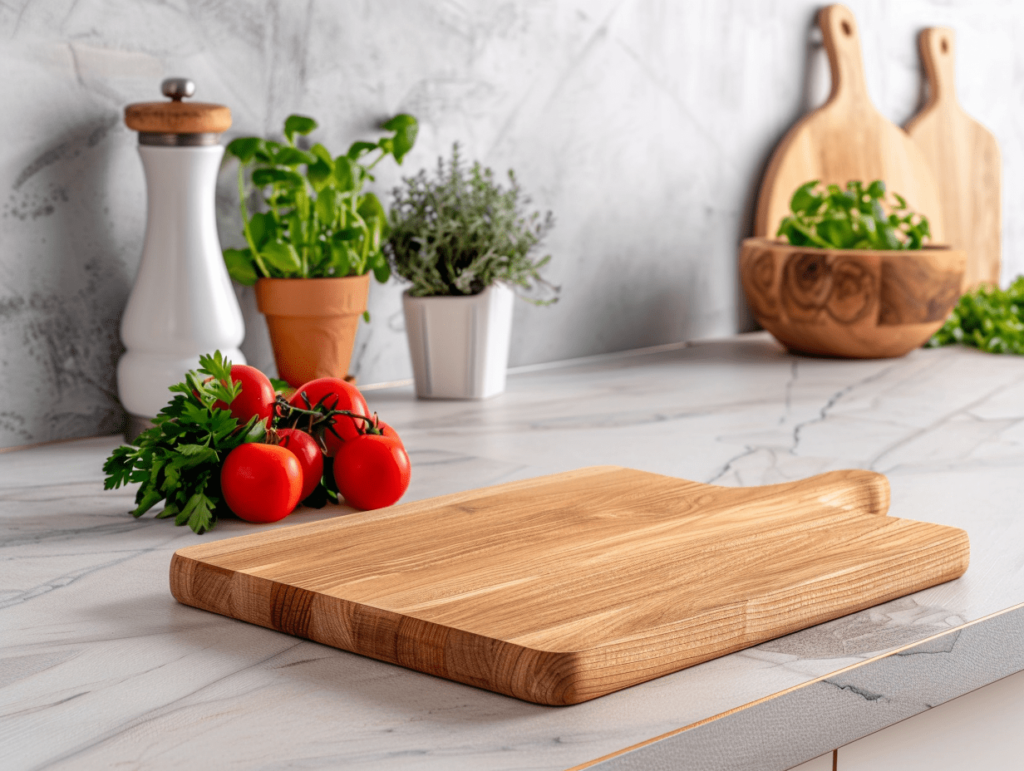
Selecting the perfect wooden cutting board involves considering several important factors that can influence its performance, durability, and suitability for your specific needs. Here are some key factors to keep in mind when making your decision:
Wood Hardness and Durability:
The hardness of the wood directly impacts its durability and ability to withstand the rigors of daily use in the kitchen. Opt for hardwoods, such as maple, walnut, or teak, which are known for their exceptional hardness and resilience against scratches and dents. A durable cutting board will maintain its integrity over time, ensuring years of reliable service in your kitchen.
Grain Pattern and Cutting Surface:
Consider the grain pattern of the wood, as it can affect both the appearance and functionality of the cutting board. Tight-grained woods, like maple and cherry, offer a smooth and uniform cutting surface that minimizes knife marks and makes cleanup easier. Conversely, open-grained woods, such as oak, may have larger gaps between fibers that can trap food particles and bacteria if not properly maintained.
Maintenance and Care Requirements:
Different wood types have varying maintenance and care requirements to keep them in optimal condition. Regular cleaning with mild soap and water, followed by thorough drying, is essential to prevent moisture absorption and bacterial growth. Additionally, periodic oiling with food-safe mineral oil helps nourish the wood and maintain its natural luster. Consider the maintenance routine that best fits your lifestyle and commitment to caring for your cutting board.
Aesthetics and Personal Preference:
The appearance of the wood cutting board is also an important consideration, as it contributes to the overall aesthetic of your kitchen. Choose a wood species that complements your kitchen decor and reflects your personal style preferences. Whether you prefer the timeless elegance of maple, the warmth of walnut, or the rustic charm of cherry, selecting a wood that resonates with you will enhance your cooking experience and bring joy to your kitchen.
Size and Thickness:
The size and thickness of the cutting board can also impact its usability and versatility in the kitchen. Consider the dimensions that best suit your cooking needs, taking into account the size of your countertop, storage space, and typical food preparation tasks. A larger cutting board offers more surface area for chopping and slicing, while a thicker board provides added stability and durability.
By carefully considering these factors, you can confidently select a wood cutting board that meets your culinary needs, complements your kitchen aesthetic, and enhances your cooking experience. Whether you prioritize durability, aesthetics, or ease of maintenance, choosing the right wood cutting board ensures years of reliable service and culinary enjoyment.
Conclusion: Best Wood For A Cutting Board
In conclusion, choosing the perfect wood cutting board is a decision that involves careful consideration of several important factors. By weighing the key aspects discussed above, you can confidently select a cutting board that meets your culinary needs, complements your kitchen aesthetic, and enhances your cooking experience.
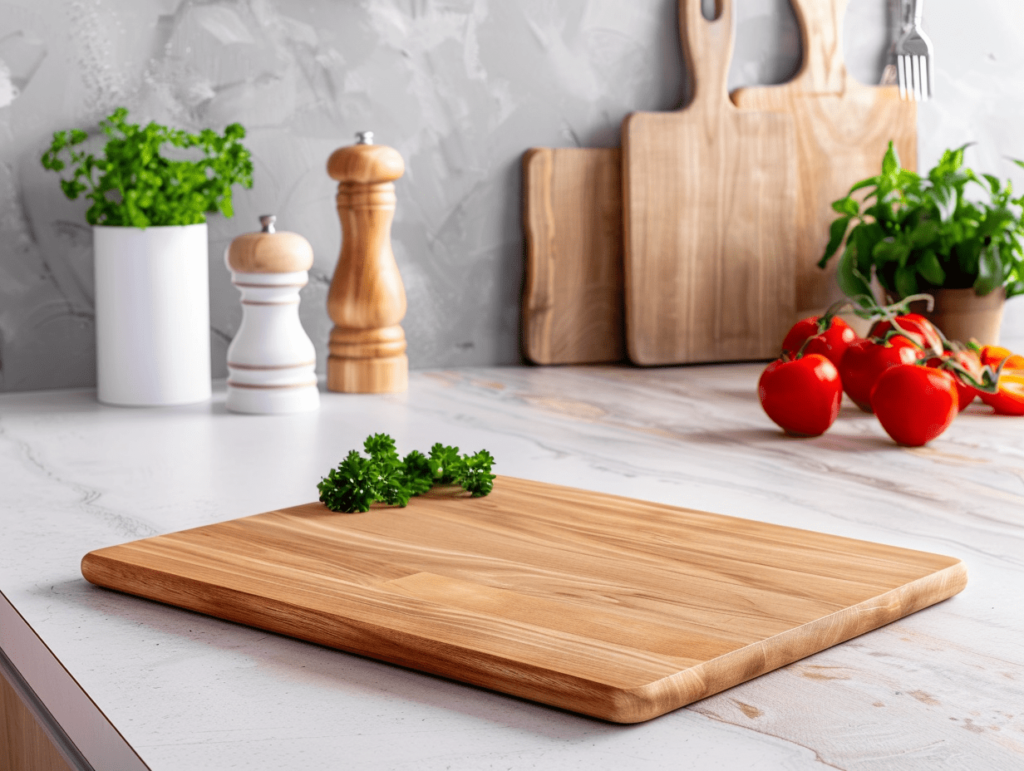
When selecting your perfect wood cutting board, remember to prioritize factors such as wood hardness and durability, grain pattern and cutting surface, maintenance and care requirements, and personal preferences in terms of aesthetics and size. Whether you opt for the timeless elegance of maple, the rich hues of walnut, the warmth of cherry, the sustainability of bamboo, or the durability of teak, there’s a wood species that’s perfectly suited to your needs and preferences.
So, take the time to explore your options, consider your priorities, and select the wood cutting board that speaks to you. Whether you’re a seasoned chef or a novice home cook, investing in the perfect wood cutting board is an investment in both your culinary journey and your kitchen space. Happy cooking!
FAQs (Frequently Asked Questions)
Q: Which wood is best for cutting boards?
A: The best wood for cutting boards depends on your preferences and needs. However, maple, walnut, cherry, bamboo, and teak are all popular choices known for their durability and suitability for cutting boards.
Q: Are wood cutting boards food-safe?
A: Yes, wood cutting boards are food-safe when properly maintained. Regular cleaning and oiling help prevent bacteria buildup and ensure your cutting board remains safe for food preparation.
Q: How do I maintain my wood cutting board
A: To maintain your wood cutting board, regularly clean it with mild soap and water, dry it thoroughly after each use, and apply a food-safe mineral oil to prevent drying and cracking.
Q: Can I use wood cutting boards for meat and vegetables?
A: Yes, wood cutting boards are versatile and suitable for cutting both meat and vegetables. However, it’s essential to clean your cutting board thoroughly between uses to prevent cross-contamination.
Q: Are bamboo cutting boards better than wood?
A: Bamboo cutting boards offer similar durability and performance to traditional wood cutting boards. However, bamboo is a sustainable and renewable resource, making it an eco-friendly choice for environmentally conscious consumers.

